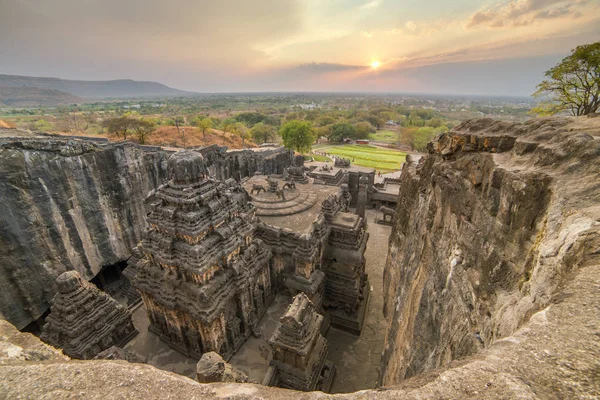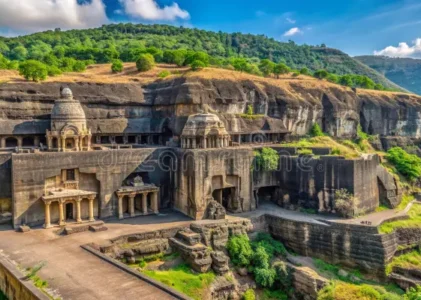Introduction
Ajanta and Ellora Caves are among the most renowned historical sites in India, embodying the rich cultural heritage and architectural brilliance of ancient times. These UNESCO World Heritage Sites, located in Maharashtra, attract millions of tourists every year. The caves represent an incredible fusion of Hindu, Buddhist, and Jain cultures, making them a must-visit for history enthusiasts, spiritual seekers, and tourists alike.
In this article, we’ll explore every facet of the Ajanta and Ellora Caves, focusing on their architectural marvels, historical importance, and travel tips to make your visit more meaningful. This comprehensive guide aims to provide SEO-rich, plagiarism-free, and detailed content while ensuring readability and adherence to AdSense guidelines.

Ajanta Caves: A Glimpse into Ancient Buddhist Art
1. History of Ajanta Caves
The Ajanta Caves date back to the 2nd century BCE, with significant contributions from the Maurya and Gupta dynasties. These 30 rock-cut caves were primarily used as monastic quarters and prayer halls for Buddhist monks, but they also served as important pilgrimage sites.
The history of the Ajanta Caves is interwoven with the evolution of Buddhism in India. The earliest caves were constructed during the Hinayana period, characterized by the simplicity and minimalism of Buddhist art. In contrast, later caves, developed during the Mahayana phase, are adorned with intricate sculptures, paintings, and carvings, reflecting the more elaborate form of worship prevalent at that time.
2. Architectural Brilliance
Each cave at Ajanta offers a unique blend of architecture and art. The caves are carved out of a horseshoe-shaped rock formation, with their exteriors bearing simple designs while the interiors are filled with elaborate frescoes and sculptures.
- Key Caves to Visit:
- Cave 1: Famous for its mural of the Padmapani and Vajrapani.
- Cave 2: Features exquisite paintings depicting Jataka tales.
- Cave 16: Known for its iconic portrayal of the “Great Departure” of Prince Siddhartha.
3. The Iconic Ajanta Paintings
The Ajanta murals are perhaps the most well-known feature of these caves. These ancient paintings, created using natural pigments, depict scenes from the life of Buddha and various Jataka tales. They also showcase everyday life, including royal processions, village scenes, and flora and fauna, making them an invaluable cultural resource.

Ellora Caves: A Confluence of Cultures
1. Historical Significance
The Ellora Caves, carved between the 6th and 10th centuries CE, reflect the religious harmony prevalent in ancient India. With 34 caves in total, Ellora is an amalgamation of Buddhist, Hindu, and Jain traditions. Unlike the Ajanta Caves, which were primarily focused on Buddhism, Ellora is a representation of India’s pluralistic religious ethos.
2. Architectural Masterpieces
The Ellora Caves are divided into three sections based on religious affiliation:
- Buddhist Caves (Caves 1-12): These include monastic structures and prayer halls with simple and elegant carvings.
- Hindu Caves (Caves 13-29): The most famous among these is the Kailasa Temple (Cave 16), which is one of the largest rock-cut temples in the world, dedicated to Lord Shiva. The temple is a marvel of engineering, as it was carved out of a single rock from top to bottom.
- Jain Caves (Caves 30-34): These caves feature intricate carvings that showcase the Jain philosophy of non-violence and spiritual purity.
3. Unique Features of the Ellora Caves
- Kailasa Temple: The temple, located in Cave 16, is an architectural wonder due to its sheer scale and the intricacy of its carvings. The temple is designed as a chariot of Lord Shiva and includes elaborate sculptures of deities, mythological figures, and celestial beings.
- Buddhist Viharas: The Buddhist caves at Ellora serve as monasteries with spacious prayer halls and meditation rooms.
- Jain Art and Architecture: The Jain caves are relatively smaller but feature highly detailed sculptures of tirthankaras and other figures from Jain mythology.

Key Differences Between Ajanta and Ellora Caves
Though both cave complexes are UNESCO World Heritage Sites and reflect the rich cultural history of ancient India, they differ in several key aspects:
- Religious Influence: Ajanta is predominantly Buddhist, while Ellora represents a confluence of Buddhism, Hinduism, and Jainism.
- Artistic Style: Ajanta is renowned for its paintings, while Ellora is famous for its sculptures, particularly the Kailasa Temple.
- Time Period: Ajanta was developed between the 2nd century BCE and 6th century CE, while Ellora’s construction spanned from the 6th to 10th centuries CE.
Tips for Visiting Ajanta and Ellora Caves
- Best Time to Visit: The ideal time to visit is between November and March when the weather is pleasant.
- How to Reach: The nearest city to both Ajanta and Ellora is Aurangabad, which is well connected by air, road, and rail.
- What to Carry: Comfortable shoes, a hat, sunscreen, and water are essential for the visit as the caves involve a lot of walking.
- Entry Fees and Timings: Both sites have different entry fees and timings for Indian and foreign nationals, so it’s advisable to check beforehand.
- Guide Services: Hiring a guide is highly recommended to understand the historical and artistic significance of the caves.
Conclusion
Ajanta and Ellora Caves are not just historical landmarks but are cultural and spiritual legacies of India’s rich past. Their intricate carvings, awe-inspiring sculptures, and vibrant frescoes offer a glimpse into the ancient civilizations that once flourished in India. Whether you are an art lover, history buff, or a traveler seeking solace in spirituality, these caves will leave you spellbound.

External link:
Internal Link:
Top Tourist Destinations in India: A Complete Travel Guide
Explore India’s Rich Culture and Tourism Wonders

